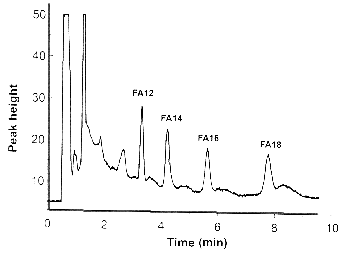
Aliphatic alcohols occur naturally in free form but more usually in esterified or etherified form. Surfactants are frequently derived from fatty alcohols like fatty alcohol sulfates, ethoxylates, and alkyl polyglycosides.
The analysis of long-chain alcohols in vegetable extracts, such as policosanols, is done after saponification, by preparative TLC and GLC. We give below a brief description of the efficient procedure used for the analysis of policosanol from peanut oil (Cherif AO et al., J Agric Food Chem 2010, 58, 12143).
Saponification : mix 5 g of oil with 50 ml of ethanolic KOH 12%(w/v) solution. The mixture is heated at 60°C for 1.30 h. After cooling, 50 ml of water are added to the mixture. The unsaponifiable matter is extracted four times with 50 ml of petroleum ether which is washed with 50 ml of ethanol/water (1:1) (v/v). The lipid fraction is dried under nitrogen, dissolved in chloroform and analyzed by TLC.
TLC : alcohols are separated into sub-fractions using one-dimensional TLC with hexane/ethanol (65:35,v/v). After development, the plates are sprayed with primuline and viewed under UV light. Bands corresponding to aliphatic alcohols are scraped off separately and extracted three times with chloroform/ethanol (1:1).
Derivatization and analysis : aliphatic alcohols are mixed with 80 ml of N,O-bis(trimethylsilyl) trifluoroacetamide and 20 ml of chlorotrimethylsilane. The mixture is vortexed and heated at 60°C for 30 min. After silylation, the solution was then directly injected to the gas chromatograph.
Sensitive techniques are often needed to evaluate their amounts in the environment or in biological samples. Thus, we give below a procedure based on a simple chemical derivatization which allows a high detection sensitivity (Meissner C et al., Chromatographia 1999, 49, 7).
Reagents and materials
Fatty alcohol standards (C12-C18), carbazole-9-carbonyl chloride (Fluka), 1-methylimidazole, RP-18 SPE cartridges (3 ml, 200 mg), RP-8 column for HPLC (125 x 4.6 mm I.D), acetonitrile, methanol, diethyl ether, HPLC pump and injector, fluorescence detector.
Procedure
Derivatization : To 860 ml dry acetonitrile 100 ml fatty alcohol and 40 ml methylimidazole catalyst were added. 1 ml carbazole-9-carbonyl chloride solution (4 mg/ml) was added to the mixture. The reaction time was 30 min at 65°C.
The reaction mixture was purified from excess reagent by filtration through a RP 18 SPE cartridge conditioned with 2 ml methanol and 2 ml acetonitrile/water (60/40, v/v). The cartridge was washed with 12 ml of acetonitrile/water (60/40, v/v), air-dried for 10 min and eluted with 2 ml diethyl ether. After removing ether under a nitrogen flow the residue is dissolved in 1 ml acetonitrile. The derivatives were stable for more than 24 h in solution.
Fatty alcohol ethoxylates were derivatized according to the same procedure.
Separation
Acetonitrile was pumped at a flow rate of 1.5 ml/min.
The excitation wavelength was 228 nm and emission was measured at 318 nm.
An example of trace analysis of fatty alcohols (injection of 200 ml of 10 nM standards from 12 to 18 carbon atoms) is given below.

A new ultrasensitive fluorescent derivatization procedure for chromatographic analysis of primary, secondary, and nonpolar tertiary alcohols has been described (Nelson TJ, Anal Biochem 2011, 419, 40-45). The procedure uses Bodipy FL in basic dichloromethane solution with Mukaiyama’s reagent (2-chloro-1-methylpyridinium iodide) to form highly fluorescent ester derivatives that can be separated by silica normal-phase high-performance liquid chromatography (HPLC).
DISPERSIVE LIQUID-LIQUID MICROEXTRACTION
Lire la suiteDevenez membre et participez au développement de la Lipidomique au XXIème siècle.
S'inscrire